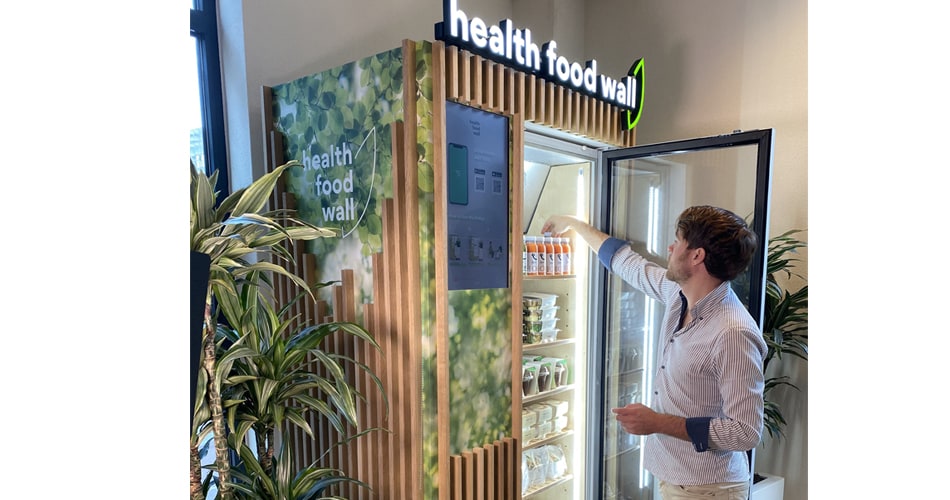
If we spend 47 days queuing over our lifetime pre-Covid, how many more days are we queuing for now?
I am a contract caterer by profession. Ch&Co acquired our business in 2014 whereafter I transferred my skills into retail foodservice consultancy.
In 2017, I consulted for Apetito at Southampton University Hospital, UK, and witnessed doctors and nurses joining two queues – one to choose and collect their food, and then another to pay for their food.
An average workforce of 150 people loses 173 hours every month queuing for lunch and evening meals. This is a complete waste of time and money, especially when lives are at risk.
No queues, no extra cost
What if front-line staff could have effortless access to fresh food and drinks anywhere and open 24/7 without queuing and without any extra labour costs for retailers?
This question took me to the US in 2018 to research robotic coffee bars and walk-in walk-out technology. In San Francisco, I visited Café X and Zippin. Both brands have invested in technology that enables customers to grab and go without queuing or checking-out.
At Zippin, I tapped a QR code, walked-in, grabbed some food, and walked out. A truly magical experience. I immediately knew this technology could really help front-line staff have more time.
Back home in the UK, I soon realised that the costs and complexities to build walk-in, walk-out technology is, today, prohibitive for most. So, instead of building an Amazon Go style grocery store, what if we could build a nano-version?

I wondered: could we shrink the tech into an upright fridge so customers could tap a debit card to unlock the door, grab some food and drinks, and go, without scanning, queuing or checking-out?
At Hungry Tech in 2019, we got to work and built a Intelligent Fridge prototype (you can see a video of ‘How It Works’ on our website www.hungrytech.co.uk) to see if we could turn the concept of ‘tap, grab and go’ into a real live working model.
The Hungry Tech prototype Intelligent Fridge 2019 is pictured, right.
Pivot or persevere?
Accuracy is critical because you need the technology to accurately determine what the customer has taken from the fridge, and to take the correct payment. The Hungry Tech prototype uses RFID technology to know what is in the fridge at any time. We managed 65% accuracy.
Then came the million dollar question: do we pivot the business or persevere? We needed £250,000 to upgrade our prototype and a further £250,000 to commence manufacturing and bring a viable product to market, over a 12 month timeline.
I consulted a patent lawyer and several industry leaders. They all said: “Find a product now and bring it to market. If you don’t, you may be too late.”
I reflected on their advice and soon after, in March 2020, I made the decision to pivot Hungry Tech from a hardware and technology provider to a sales and software on-boarding company, partnering with Husky International.
Husky have their own Intelligent Fridge built at 100% accuracy. Husky also own the whole supply chain with their own factory and tech team, which enables Hungry Tech to provide a fully customisable intelligent solution to foodservice retailers right now. We can bespoke the technology and white-label to any brand for organisations who share our vision of dozens of embedded retail nano-stores across their estates and into new locations.
The data ‘grab’ from the fridge provides a real time inventory of ‘what’s in the fridge, right now’: best sellers; healthy meals sold; productivity hours saved (by not going-out and queuing); and bespoke discounting, so retailers can measure the value of working with Hungry Tech.
Crucially, the software enables businesses to connect with their customers to gather consumer insights and to build loyalty with personal push notifications.
It takes around seven and a half minutes to tag and re-stock the Intelligent Fridge with labour already on-site so with no additional overheads. Unlike traditional vending machines that take 55 seconds to vend one bottle of water, or micro-markets that rely on honesty and a 12 second scan to check-out, customers take only a few seconds to grab several items from the Intelligent Fridge so the average transaction is much higher at £5 – £7 per head. There is zero shrinkage versus 2% to 15% in micro-markets with scanning terminals.
The new Intelligent Fridge 2020 is pictured, right.
Convenient, easy
We recently signed a deal with Aramark to supply Intelligent Fridges, and we are in active discussions with a number of contract caterers and high street retailers who all share a common problem – how do we provide convenient easy access to fresh food and drinks 24/7 for our customers, without the additional overheads?
Husky have a product roadmap planned to include compact and double sized Intelligent Fridges; an Intelligent Freezer; and an Intelligent Pantry for grab and go groceries. A modular approach where caterers can reduce their foodservice according to volumes, or to extend their reach of fresh food across a large estate.
To conclude, my key learnings over the 18 months are:
- The Intelligent Fridge solves a common industry problem
- The experience for customers is magical
- Grab and go, walk-in, walk-out technology will be normal within 3-5 years
- Data is the new oil for hospitality
- The value of this data is maximised through consumer personalisation
Further details:
Please get in touch when I can talk you through the juicy bit: the numbers! Otherwise, please visit the Hungry Tech website, here.
Julian Davis Smith
